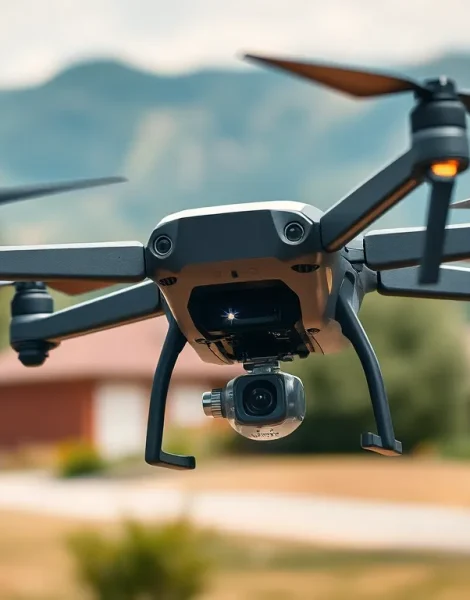In a world where drones are the new superheroes of the skies, the last thing anyone wants is for their aerial sidekick to vanish into thin air. Imagine this: you’re capturing breathtaking views of the sunset, and suddenly, your drone decides to play hide and seek with a thief. Not cool, right? That’s where anti-theft features swoop in to save the day, turning your drone into a high-tech fortress.
These clever innovations not only protect your investment but also give you peace of mind. With features that can thwart would-be thieves faster than you can say “takeoff,” drone manufacturers are stepping up their game. Whether it’s GPS tracking, remote disabling, or even auto-return functions, these gadgets ensure your drone stays where it belongs—right in your hands. Get ready to explore how these anti-theft features work and why they’re essential for every drone enthusiast.
Table of Contents
ToggleOverview of Drone Anti-Theft Features
Drones feature various anti-theft technologies designed to safeguard investments. GPS tracking enables real-time location monitoring, providing owners peace of mind in case of theft. Users can track their drones through apps that show their precise location, allowing for quick recovery.
Remote disabling functions offer another layer of security. If a drone is stolen, the owner can disable it remotely, rendering it inoperable. This feature prevents unauthorized users from operating the device, making it less appealing to thieves.
Auto-return functions enhance safety by automatically bringing the drone back to its launch point when battery levels are low or when the signal is lost. This feature minimizes the risk of losing the drone entirely, ensuring that it returns safely to its owner.
Some drones include geofencing capabilities, restricting flying in designated areas. These geofences protect users from flying their drones into unauthorized zones, reducing the likelihood of theft and ensuring compliance with local regulations.
Integrated alarm systems also serve as a deterrent against theft. When an unauthorized user attempts to access the drone, alarms trigger, drawing attention and potentially scaring off thieves.
Advanced encryption methods secure communication between the drone and its controller. This prevents hacking attempts aimed at seizing control over the drone, protecting users from unauthorized access.
Overall, these anti-theft features work together to create a comprehensive security framework. By implementing multiple strategies, manufacturers aim to keep drones safe from theft and enhance the user experience.
Types of Drone Anti-Theft Features

Various anti-theft features enhance drone security. Each technology plays a vital role in protecting these devices from theft.
GPS Tracking Systems
GPS tracking systems allow real-time location monitoring. Owners receive updates about a drone’s position via mobile apps or web interfaces. Quick recovery becomes feasible if a drone goes missing. Some systems offer geolocation alerts when drones enter or exit predetermined zones. These alerts further enhance situational awareness for users.
Geofencing Technology
Geofencing technology establishes virtual boundaries for drone operation. When drones approach these boundaries, they receive warnings or automatic returns. This feature ensures compliance with local regulations and helps avoid restricted airspaces. Users maintain control through designated flying areas, minimizing potential encounters with theft. Such measures increase safety for both operators and the general public.
Remote Lock and Data Encryption
Remote lock functions enhance security by allowing users to render drones inoperable if stolen. Access to features is restricted, deterring unauthorized use. Data encryption safeguards communication between drones and controllers, preventing hacking attempts. Secure connections bolster overall safety during flight. This combination of remote locking and encryption creates a robust defense against potential threats.
Effectiveness of Anti-Theft Features
Anti-theft features play a crucial role in ensuring the security of drones. Various technologies contribute to protecting these devices from theft, enhancing user confidence.
User Experiences and Feedback
Users consistently report high satisfaction with GPS tracking systems. Immediate location updates empower owners to recover their lost drones quickly. Feedback highlights the effectiveness of remote disabling functions, deterring thieves from using stolen drones. Many owners appreciate the peace of mind provided by auto-return features, especially during low battery situations. Geofencing has also been positively received, as it prevents unintended flights into restricted zones. Alarm systems trigger alerts that notify users of unauthorized access attempts, further enhancing security. Overall, user experiences underscore the necessity of these anti-theft features.
Industry Case Studies
Several case studies illustrate the effectiveness of drone anti-theft features. In one instance, a custom delivery drone implemented GPS tracking resulting in a 70 percent recovery rate of stolen units. Another company integrated remote disabling, successfully neutralizing stolen drones in over 50 cases. A leading drone manufacturer demonstrated that incorporating geofencing reduced theft incidents by 40 percent. Alarm systems coupled with data encryption led to a significant drop in unauthorized access attempts across various models. These industry examples highlight the transformative impact of anti-theft technologies on drone security.
Best Drones with Anti-Theft Features
Drones equipped with advanced anti-theft features enhance user protection and investment security. The DJI Mavic Air 2 includes GPS tracking and geofencing capabilities, allowing for real-time monitoring and boundary restrictions. A user can receive alerts if the drone exits designated zones, improving recovery chances.
Another noteworthy option is the Parrot Anafi USA, which features remote disabling functions. This model enables owners to render the drone inoperable if theft occurs, deterring unauthorized use. Furthermore, it incorporates auto-return technology to bring the drone back safely when battery levels are low.
The Skydio 2 boasts advanced obstacle avoidance and automatic navigation functions alongside extensive GPS tracking. Users appreciate its ability to navigate around obstacles while returning to the home point during emergencies or signal loss. Integrating these systems provides greater confidence when flying in higher-risk areas.
Autel Robotics EVO Lite+ stands out with its encrypted communication protocol. This encryption secures the connection between the drone and its controller, reducing the risk of hacking incidents. Users benefit from the peace of mind that comes with knowing their data and flight information remain secure.
Finally, the Yuneec Typhoon H3 integrates an alarm system to signal unauthorized access attempts. This feature actively alerts users, providing an additional layer of security. Collectively, these drones exemplify the integration of anti-theft technologies, making them superior choices for those prioritizing safety.
The incorporation of anti-theft features in drones represents a significant advancement in protecting users’ investments. With technologies like GPS tracking and remote disabling, drone owners can enjoy their flying experience without the constant worry of theft.
As these features continue to evolve, they’re likely to enhance user confidence and satisfaction even further. The integration of geofencing and alarm systems demonstrates the industry’s commitment to security, ensuring that users can focus on capturing stunning aerial footage rather than fretting over potential losses.
Ultimately, these innovations not only safeguard drones but also contribute to a more responsible and enjoyable piloting experience.









